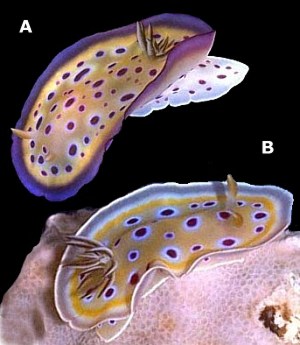
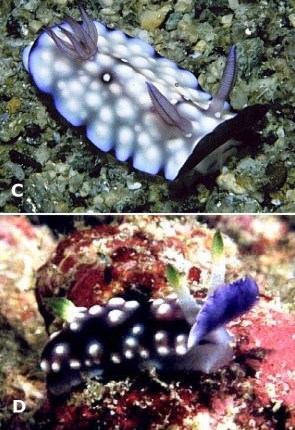
Mantle flapping in Chromodoris
PHOTO
A,B. Chromodoris kuniei (A) and Chromodoris geminus (B) showing 'mantle-flapping' in which the whole of the mantle edge rises simultaneously and then falls simultaneously. Photos: Bill Rudman.
C,D. Chromodoris hintuanensis (C) and Chromodoris geometrica (D) showing 'mantle-flapping' in which only the front of the mantle edge rises falls in a rhythmic wave. Photos: Mary Jane Adams (C), Erwin Koehler (D).
Within the Chromodorididae there are a number of interesting behavioural traits which are found amongst certain groups of species. Species of Risbecia exhibit 'trailing' where two animals will pair up with one following close behind the other. Many species of Thorunna and some species of Noumea rhythmically wave their gills as they crawl along.
Amongst species of Chromodoris there are two groups of species which flap their mantles in a rhythmic way. Chromodoris kuniei, Chromodoris geminus and Chromodoris tritos show 'mantle-flapping' in which the whole of the mantle edge rises simultaneously and then falls simultaneously. All species are similarly coloured and appear to form a group of allopatric sibling species [each with non-overlapping geographic distributions]. Another species pair with this type of mantle-flapping are Chromodoris coi, from the western Pacific and its sibling species, Chromodoris gleniei from the western Indian Ocean. There is a good photo of C. coi mantle-flapping on the C. coi page.
Chromodoris hintuanensis and Chromodoris geometrica show a different type of 'mantle-flapping' in which only the front of the mantle edge rises and falls in a rhythmic wave. It seems the species that belong to this behavioural group also have a bright purple colouration on the underside of the anterior mantle.
At this stage we have no idea what the 'purpose' is, if any, for this type of behaviour.
If anyone comes across this or any other peculiar behaviour pattern I would very much like to hear of it so we can record it on the Forum and alert others to look out for similar happenings.
Bill Rudman.
Authorship detailsRudman, W.B., 2000 (June 13) Mantle flapping in Chromodoris. [In] Sea Slug Forum. Australian Museum, Sydney. Available from http://www.seaslugforum.net/find/mantflap
Related messages
Re: Mantle flaring in Chromodorididae
June 4, 2008
From: Teresa Zuberbühler
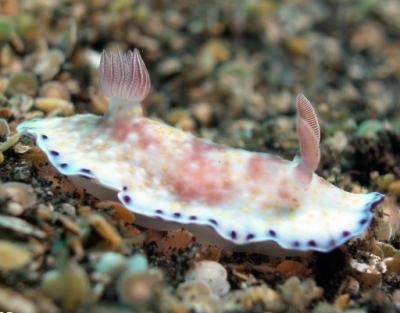
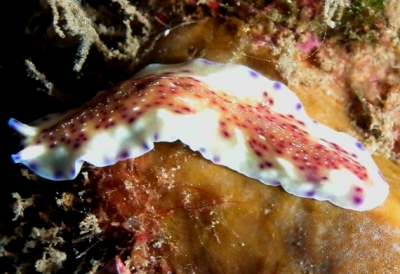
Concerning message #2566:
Dear Bill
I have seen mantle flapping quite often in the following species: Chromodoris aureopurpurea, Chromodoris coi, Chromodoris kuniei.
My private theory is, that the flapping makes the nudibranch looks very much like a flatworm. All these nudibranchs have a colorful edge which is clearly visible when flapping, same as many flatworms.
As an example I send you a picture of two species of flatworms (Pseudoceros cf laingensis [lower photo] and Pseudoceros sp.7[middle photo]) that looks like Chromodoris aureopurpurea. These flatworms are found mostly in corals reefs, not sandy areas.
Locality: Indonesia, Pacific, 2003 to 2006, Reef. Photographer: Teresa (Zubi) Zuberbühler.
Teresa Zuberbühler
webmaster@starfish.ch
Zuberbühler, T., 2008 (Jun 4) Re: Mantle flaring in Chromodorididae. [Message in] Sea Slug Forum. Australian Museum, Sydney. Available from http://www.seaslugforum.net/find/21610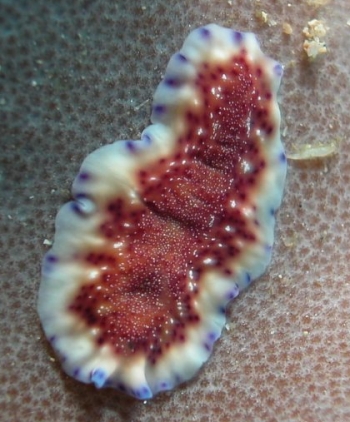
Dear Zubi,
Among the behavioural oddities in nudibranchs, 'mantle flapping' can be one of the most spectacular, with some sending an irregular wave along both sides of the mantle, some just flapping the anterior end, and others raising and lowering the whole of the mantle edge in a single movement. Certainly this can at times look like the waves along the edge of a flatworm's body, but I don't know if we could ever determine whether this waving has evolved to mimic the movement of the flatworm. My feeling [no proof] is that the chromodorids wave the edge of the mantle - which is where they concentrate nasty chemicals - to attract potential predators to the most distasteful and potentially sacrificial parts of their body. Predators would taste the wriggling bits, get a mouthful of nasty chemicals, and leave the rest of the body alone.
An important question when we consider two or more very similarly coloured animals is whether the similarity is just a co-incidence or is one trying to mimic the other? As I discuss on the mimicry Fact Sheet, if mimicry is involved, how do we decide which is the model and which is the mimic? There are certainly many nudibranchs and flatworms which look alike. I am not sure how we are going to discover whether the flatworm or the nudibranch evolved their colour pattern first. Until we know that, we can't really say whether nudibranchs evolved mantle-flapping to look like flatworms, or vice versa. It is an interesting question - just the thing to discuss on a long boat trip home from a dive.
Best wishes,
Bill Rudman
Mantle flaring in Chromodorididae
June 15, 2000
From: Ray Izumi
Dear Bill,
I have often observed Chromodoris coi and Chromodoris kuniei travelling along the substrate, periodically flaring out their mantle, raising it above the body. Is there an explanation for this odd behavior?
Ray Izumi
izumirm@sprynet.com
Izumi, R., 2000 (Jun 15) Mantle flaring in Chromodorididae. [Message in] Sea Slug Forum. Australian Museum, Sydney. Available from http://www.seaslugforum.net/find/2566Dear Ray,
Both these species 'flare' or 'flap' there mantle. Have a look at the page I have prepared on 'Mantle-flapping' in response to your question. I'm afraid I can't say why they do it, but any behavioural observations are welcome.
Best wishes,
Bill Rudman.
